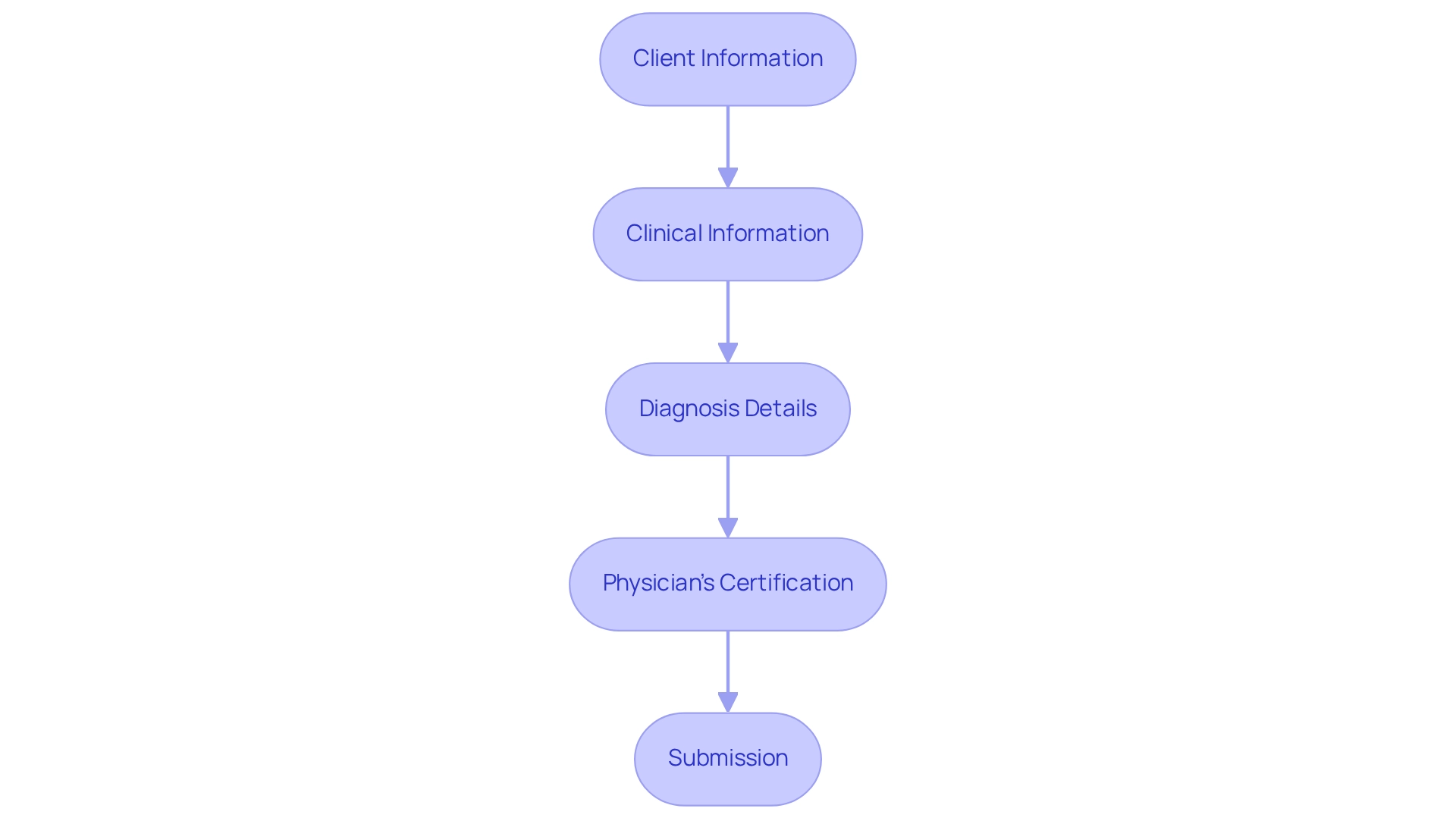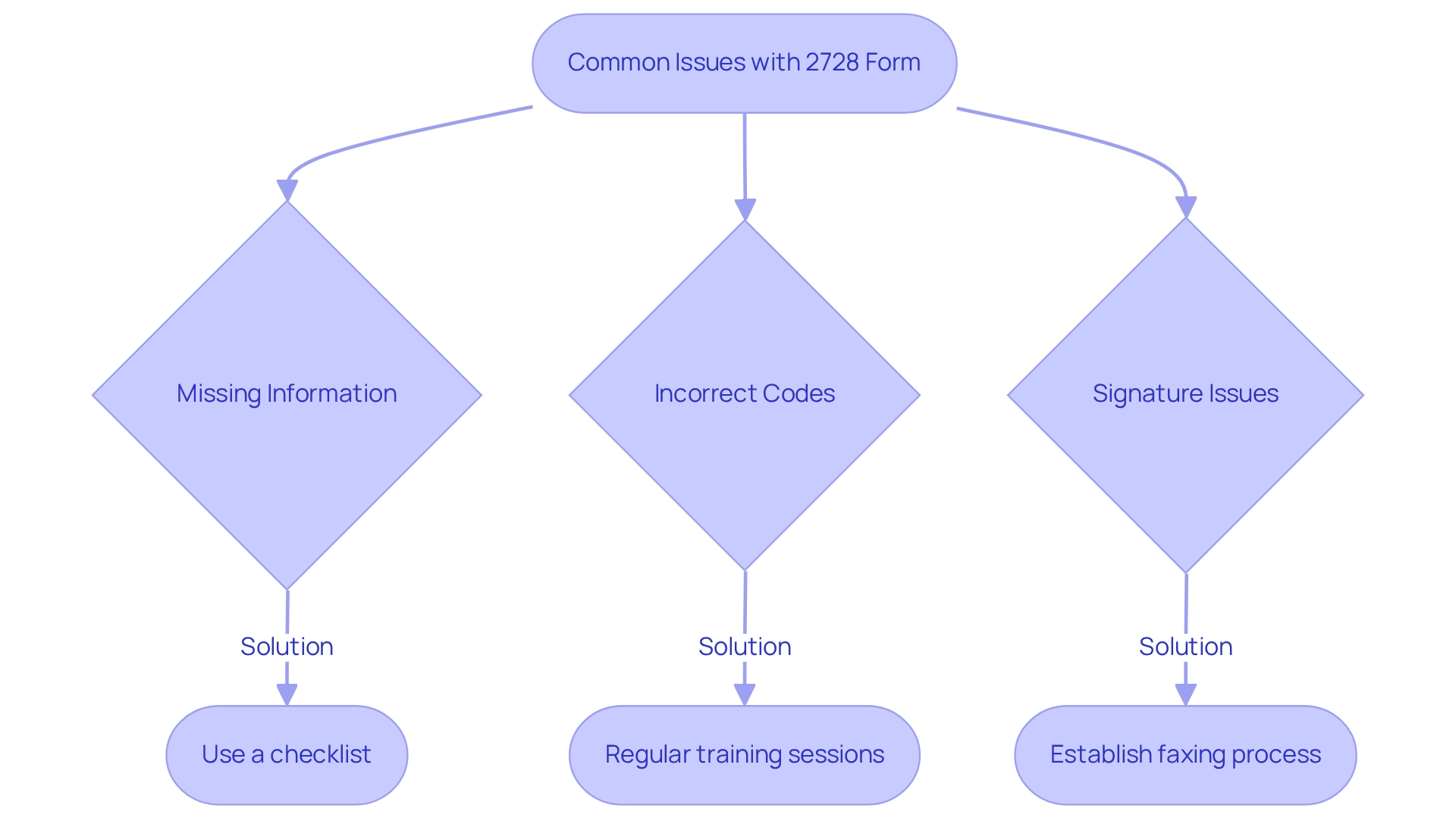Overview
This article serves as a comprehensive guide to completing the 2728 Form, a crucial document for establishing Medicare eligibility for individuals diagnosed with End-Stage Renal Disease (ESRD) and ensuring their registration in a national renal registry. The critical steps for accurate completion are outlined, emphasizing that timely submission is paramount. Common issues that may arise during the process are discussed, underscoring the necessity for meticulous attention to detail and thoroughness. Such diligence can significantly enhance access to essential treatments and improve overall health outcomes.
Introduction
Navigating the complexities of the CMS 2728 Form is essential for healthcare professionals involved in the care of patients with End-Stage Renal Disease (ESRD). This vital document not only establishes Medicare eligibility but also plays a crucial role in registering patients within a national renal registry, ensuring they receive timely access to necessary treatments.
With a strict 45-day window for completion, understanding the intricacies of this form can significantly impact patient outcomes. This article delves into the critical steps and best practices needed to streamline the completion of the CMS 2728 Form, ultimately enhancing the quality of care for those battling ESRD.
From gathering essential patient information to troubleshooting common pitfalls, mastering this process is imperative for improving patient care.
Understand the Purpose of the 2728 Form
The CMS document, officially known as the End Stage Renal Disease (ESRD) Medical Evidence Report, is pivotal in the Medicare entitlement process. It serves two essential functions:
- It provides the necessary medical evidence to establish an individual’s ESRD condition for Medicare eligibility.
- It registers the individual in a national renal registry.
Timeliness is crucial; the document must be completed within 45 days of the individual’s initial treatment for ESRD, which is vital for ensuring swift access to Medicare benefits.
Statistics reveal that a significant percentage of ESRD individuals successfully complete the required paperwork within this timeframe, underscoring its importance in enabling prompt care. Healthcare experts emphasize that this document is not merely a bureaucratic necessity but a critical tool that enhances health outcomes by facilitating the transition into treatment programs. Expert insights highlight that the document’s comprehensive nature aids in gathering vital information about individuals, essential for efficient care management.
Moreover, case studies demonstrate the positive impact of the CMS document on Medicare eligibility for ESRD individuals, illustrating how meticulous completion can lead to improved access to necessary treatments. The ESRD Medical Evidence Report is therefore not just a regulatory requirement; it is a fundamental component in the continuum of care for individuals with end-stage renal disease, ensuring they receive the benefits and support they need.
Gather Required Information for the 2728 Form
To effectively complete the 2728 form, it is essential to gather comprehensive information about individuals beforehand. This includes:
- Demographics such as the individual’s name, date of birth, address, and contact information.
- Medical history documenting the date of End-Stage Renal Disease (ESRD) diagnosis and the initiation of treatment.
- Clinical data, which records vital statistics like height, weight, and serum creatinine levels.
- Causes of renal failure, identifying both primary and secondary factors contributing to the individual’s condition.
- Physician information, ensuring the form includes the attending physician’s signature and credentials.
Moreover, understanding the role of NDC and HCPCS codes is crucial in defining interventions and tracking treatment pathways. These codes assist providers in navigating the individual’s journey from diagnosis through lines of therapy, ensuring that all necessary treatments are documented and approved under Medicare benefits. Having this information readily available not only streamlines the completion process but also minimizes the risk of errors, which is vital for accurate reporting and care.
Statistics indicate that prompt submission of the 2728 form, which must occur within 45 days of the admit date, significantly enhances the quality of data gathered for kidney disease research and care management. Case studies have shown that improving the precision of demographic information on these forms can lead to better outcomes for individuals and more focused educational initiatives. By adhering to these best practices, healthcare providers can ensure compliance with the latest guidelines for completing the required document, ultimately enhancing care for individuals and fostering strategic growth in the healthcare sector.
CareSet’s comprehensive Medicare data solutions empower healthcare strategies by offering insights from over 62 million beneficiaries and 6 million providers, enabling providers to make informed decisions based on accurate data. As Francis Peabody stated, ‘True healing goes beyond medical treatment; it involves genuinely caring for the individual’s well-being,’ underscoring the critical importance of accurate data collection in person-centered care.
Complete the 2728 Form Step-by-Step
To accurately complete the 2728 form, it is important to follow these essential steps:
-
Client Information: Enter the client’s full name, date of birth, and Medicare number. Double-check for accuracy to prevent processing delays.
-
Clinical Information: Record the individual’s height, weight, and serum creatinine levels. Ensure this data is current, ideally obtained within 45 days prior to the patient’s initial treatment.
-
Diagnosis Details: Clearly indicate the primary and secondary causes of renal failure using the correct ICD-10 codes to ensure proper classification.
-
Physician’s Certification: The attending physician must endorse the document, verifying the accuracy of all provided information, which is crucial for compliance.
-
Submission: Submit the completed form to the designated ESRD Network within the specified timeframe. It is essential that all sections are thoroughly filled out to avoid any delays in processing the 2728 form, as common errors can significantly impact processing times. For instance, inaccuracies in patient information or missing signatures can lead to unnecessary delays. Optimal methods involve checking the document for thoroughness and precision prior to submission. Healthcare professionals emphasize that even minor mistakes can result in significant setbacks, underscoring the importance of meticulous attention to detail when filling out the form.

Troubleshoot Common Issues with the 2728 Form
Completing the 2728 form can present several challenges that may result in delays or rejections. Statistics indicate that a significant percentage of forms are rejected due to missing information or incorrect codes, underscoring the importance of thoroughness in the completion process. Here are some common issues and their solutions:
-
Missing Information: It is crucial to ensure that all required fields are filled out completely. Forms with incomplete information are frequently declined, which can greatly affect care timelines for individuals. Implementing a checklist before submission can help mitigate this issue.
-
Incorrect Codes: Verify that the ICD-10 codes for renal failure are accurate and current. Utilizing outdated codes can result in processing delays. Regular training sessions for staff on coding updates can enhance accuracy. Furthermore, confirm that NDC and HCPCS codes are accurately utilized, as these codes are crucial for defining interventions and aiding individuals in navigating through treatment pathways.
-
Signature Issues: The document must be signed by the treating physician. If the physician is unavailable, establishing a faxing process for signatures can expedite submission. This proactive approach can prevent unnecessary delays in processing.
Submission deadlines indicate that the 2728 Form must be submitted within 45 days of the individual’s first treatment. Setting automated reminders can help ensure that this critical deadline is not missed. In case of technical difficulties, reaching out to the EQRS help desk promptly can provide necessary support.
A recent study highlighted that discrepancies in comorbidity data can lead to inaccurate patient assessments, emphasizing the need for meticulous data collection practices. Healthcare providers have expressed concerns regarding the challenges they face when submitting the 2728 form. One provider remarked, “The intricacy of the document often results in mistakes that might have been prevented with more explicit instructions.”
Case studies have shown that implementing systematic reviews of completed forms can enhance accuracy and reduce the likelihood of rejection. By addressing these common issues and employing effective troubleshooting strategies, healthcare professionals can enhance the submission process for the 2728 Form, ultimately benefiting patient care outcomes.

Conclusion
Understanding and accurately completing the CMS 2728 Form is pivotal for healthcare professionals managing patients with End-Stage Renal Disease (ESRD). This form not only facilitates Medicare eligibility but also ensures that patients are registered in a national renal registry, enabling timely access to essential treatments. The importance of submitting this form within the mandated 45-day timeframe cannot be overstated, as it directly influences patient outcomes and the overall quality of care.
Gathering comprehensive patient information, including demographics, medical history, and clinical data, is crucial for the successful completion of the form. By adhering to a systematic step-by-step approach, healthcare providers can minimize errors and enhance the accuracy of the data submitted. It is essential to recognize potential pitfalls, such as missing information or incorrect coding, and implement proactive strategies to address these issues. Regular training and clear communication within healthcare teams can significantly mitigate the risk of delays caused by common errors.
Ultimately, mastering the CMS 2728 Form transcends a mere regulatory requirement; it embodies a fundamental aspect of patient-centered care that can dramatically improve the treatment journey for those battling ESRD. By prioritizing thoroughness and accuracy in the completion of this vital document, healthcare professionals can play a crucial role in enhancing patient outcomes and ensuring that individuals receive the care and support they need.


